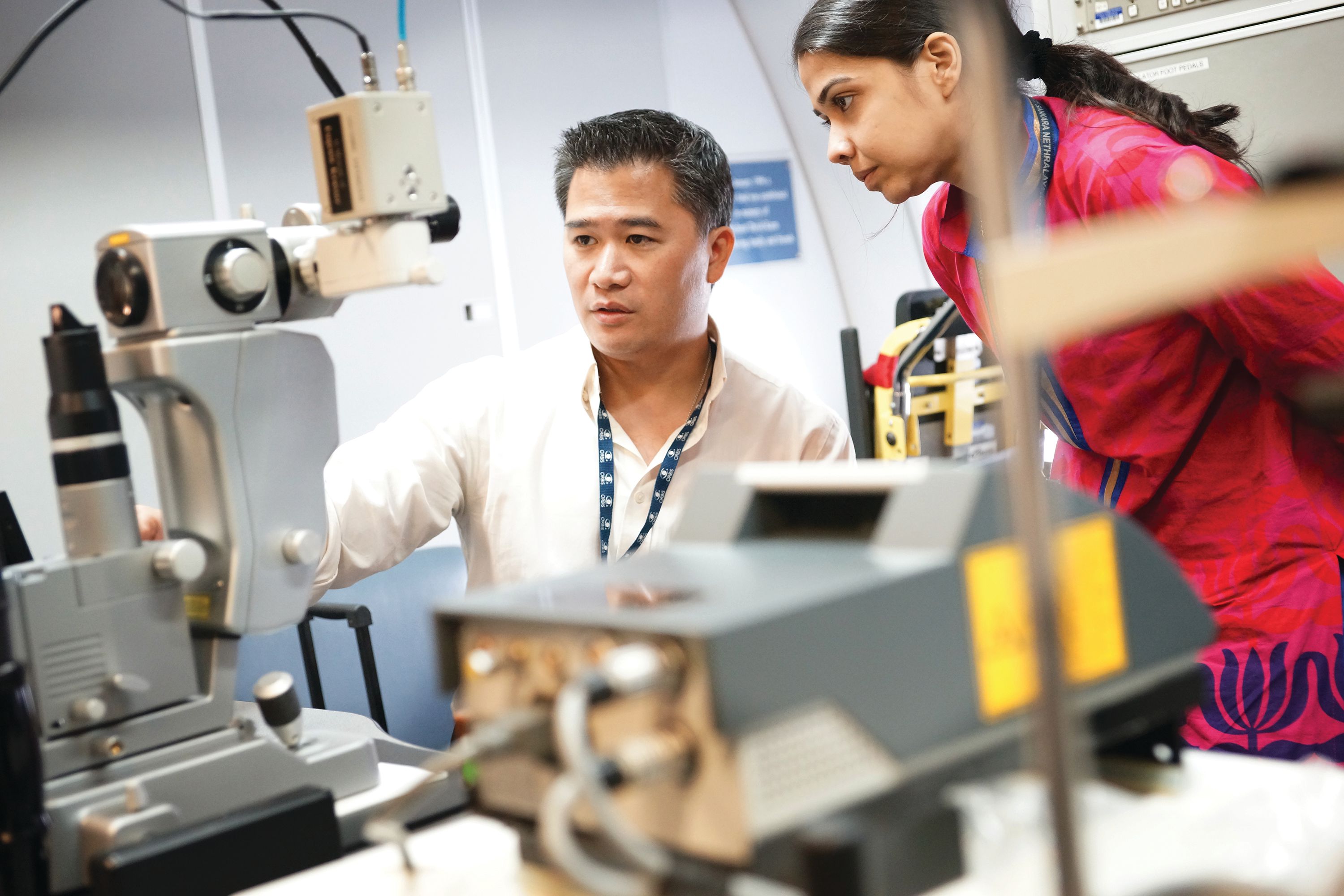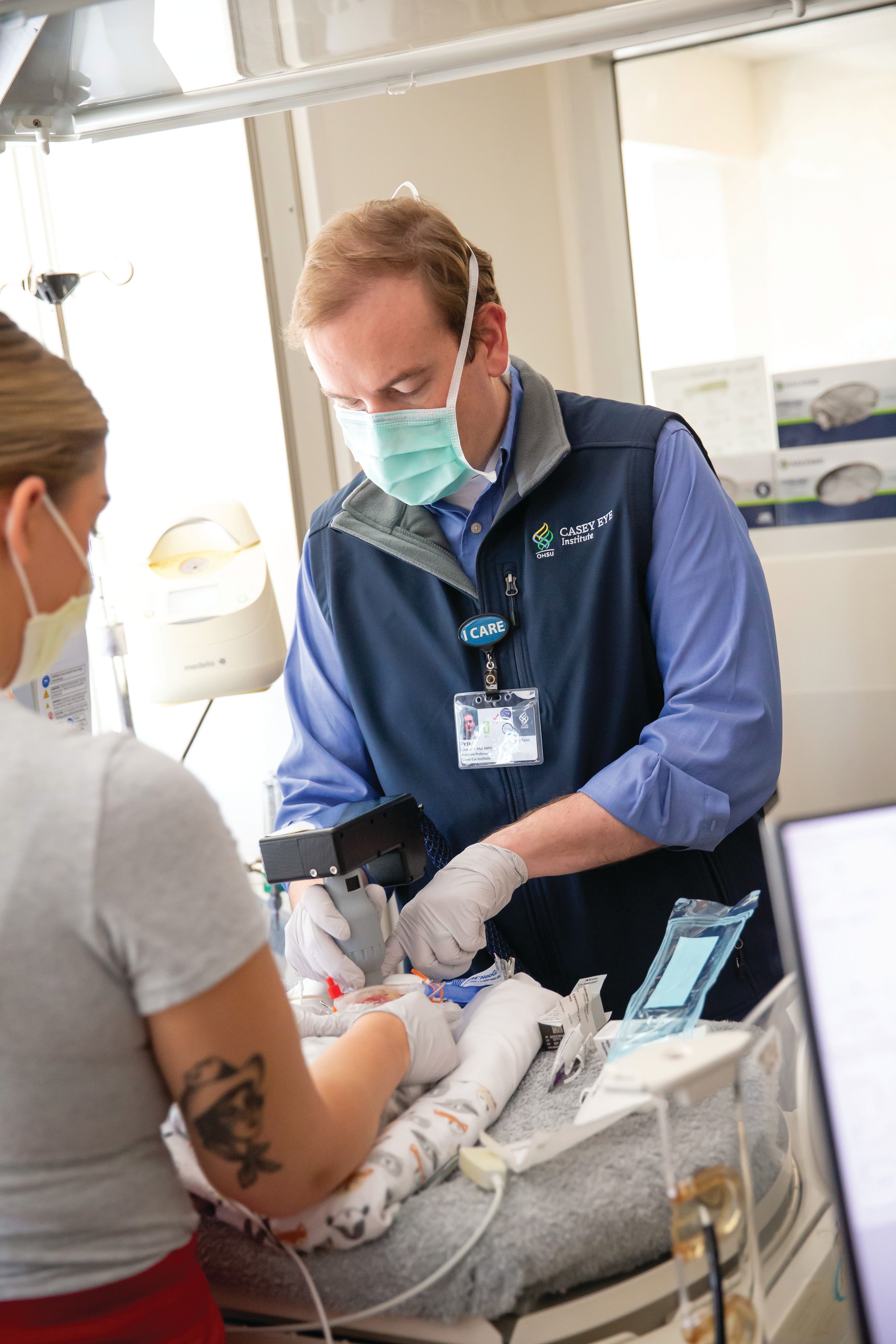Global partnership targets ROP in premature infants
An AI-supported telemedicine effort from Siloam Vision and Orbis International
Siloam Vision and Orbis International recently announced a strategic partnership to develop sustainable infrastructure to save the vision of premature infants in low- and middle-income countries. Siloam and Orbis work to reduce avoidable blindness and vision loss globally; together, they are rolling out new technology to reach remote areas with limited access to specialised eye care professionals.
The partnership is poised to use Siloam’s artificial intelligence (AI) platform that helps diagnose retinopathy of prematurity (ROP), the leading cause of childhood blindness globally. Orbis—drawing on its deep knowledge of telemedicine, partnerships with local eye hospitals around the world, and focus on educating eye care professionals—will help roll out the platform in hard-to-reach areas.
R. V. Paul Chan, MD, trains eye teams on board the Orbis Flying Eye Hospital in 2013. (Image courtesy of Geoff Oliver Bugbee)

Siloam’s system, i-ROP DL, is an ROP screening solution. Results of external validation studies in India, Nepal and Mongolia show the i-ROP DL system effectively identifies severe ROP in digital images taken on commercially available cameras.1 It offers the cloud infrastructure to provide telemedicine service worldwide. The proprietary i-ROP DL system has received FDA breakthrough designation and is one of the few ophthalmic devices to achieve this status in nearly a decade.2 Siloam was awarded $1.95 million from the National Institutes of Health to perform the necessary clinical studies to obtain FDA approval of the technology.
About ROP
ROP is a potentially blinding eye disease that affects premature infants and is a leading cause of blindness among children worldwide, specifically in low- and middle-income countries.3 Improvements in the capacity and care of neonatal units in these areas are leading to more babies surviving premature birth; however, with all premature babies at risk of developing ROP, and limited integration of ROP screening programs and resources in low- and middle-income countries, we are also seeing an associated increase in the risk of blindness from ROP.4
Although blindness from ROP is highly preventable, challenges around ROP screening are multifaceted. First, training enough ROP specialists in the regions where they are needed most takes time that is outpaced by the volume of babies needing screening. Screening for ROP is time intensive, with examinations occurring multiple times a week for several months. Further, the equipment and infrastructure for effective screening programs are expensive and complicated, especially in low-resource areas.
The power of AI and telemedicine
Traditional telemedicine models are a partial solution, bringing virtual consultation from ROP specialists to areas that do not have adequate access to trained ophthalmologists. Yet, as mentioned, screening for ROP is labour intensive, with volumes outpacing the availability of telemedicine consults. A force multiplier is needed, and AI solutions are promising.
Orbis has ROP programs in Mongolia, Peru and Vietnam. Orbis works with partners in those countries to improve the standards of ophthalmic facilities to provide diagnosis, treatment and follow-up care to premature infants, while also providing training in laser and surgical treatment for eye care professionals to improve outcomes and avoid high complication rates. Through thoughtful integration of neonatal and ophthalmic care, ROP cases are identified early and patients receive treatment to prevent permanent blindness.
J. Peter Campbell, MD, examines an infant at Oregon Health & Science University. (Image courtesy of OHSU/John Valls)

Additionally, the Orbis telemedicine and e-learning platform Cybersight offers a variety of ROP resources for eye health professionals, including live lectures, online courses, and mentorship through patient consults with world-leading ophthalmology experts. Cybersight also has its own AI offerings capable of detecting and visualising glaucoma, macular disease, and diabetic retinopathy. Through its partnership with Siloam, Orbis will expand AI offerings for ROP with established partners in low- and middle-income countries.
Together, Siloam and Orbis have experience in telemedicine and AI implementation. Their partnership allows for the immediate opportunity to scale i-ROP DL in regions that may not be able to have access to the technology without the implementation support from a nonprofit organisation. As is common with many technology and AI solutions, the up-front expense for implementation and training can be cost prohibitive, especially in low-resource areas, whereas the ongoing expenses become more manageable and sustainable. The partnership’s goal is to not only install this technology in areas with limited ophthalmic resources but to create an effective, scalable and sustainable solution that can span the globe to make sure no infant goes blind from ROP.
References
1. Cole E, Valikodath NG, Al-Khaled T, et al. Evaluation of an artificial intelligence system for retinopathy of prematurity screening in Nepal and Mongolia. Ophthalmol Sci. 2022;2(4):100165. doi:10.1016/j.xops.2022.100165
2. Breakthrough devices program. FDA. Updated September 14, 2023.Accessed October 4, 2023. https://www.fda.gov/medical-devices/how-study-and-market-your-device/
breakthrough-devices-program
3. Burton MJ, Ramke J, Marques AP, et al. The Lancet Global Health Commission on Global Eye Health: vision beyond 2020. Lancet Glob Health. 2021;9(4):e489-e551. doi:10.1016/S2214-109X(20)30488-5
4. Sabri K, Ells AL, Lee EY, Dutta S, Vinekar A. Retinopathy of prematurity: a global perspective and recent developments. Pediatrics. 2022;150(3):e2021053924. doi:10.1542/peds.2021-053924
J. Peter Campbell, MD | E: info@siloamvision.com
Campbell is cofounder and chief executive officer, Siloam Vision; chairman of the American Academy of Ophthalmology Committee on Artificial Intelligence; and coinventor of the i-ROP DL algorithm that received breakthrough designation from the FDA.
R. V. Paul Chan, MD | E: info@siloamvision.com
Chan is the cofounder of Siloam Vision; head of the Department of Ophthalmology, University of Illinois College of Medicine, Chicago; and coinventor of the i-ROP DL algorithm that received breakthrough designation from the FDA.
Hunter Cherwek, MD | P: 800-672-4787
Cherwek is vice president of clinical services and technologies at Orbis International, a nonprofit organisation dedicated to eliminating avoidable vision loss by ensuring everyone has access to quality eye care, no matter where they live.
